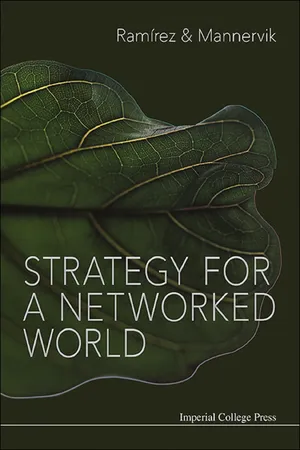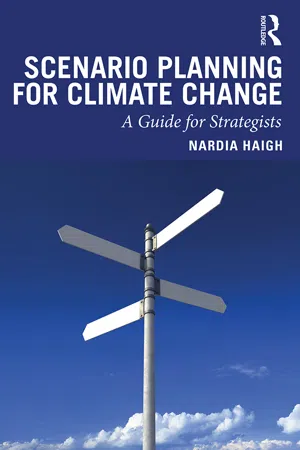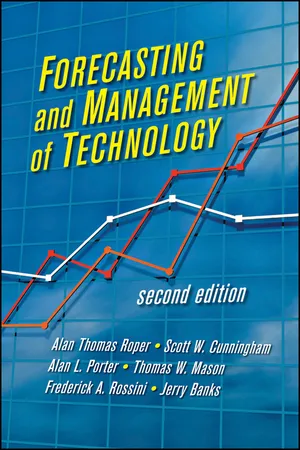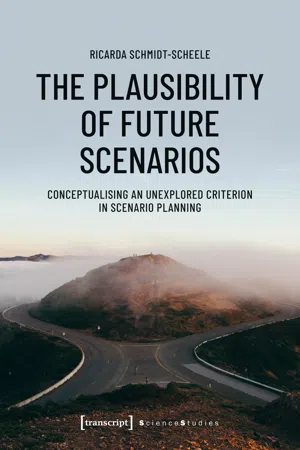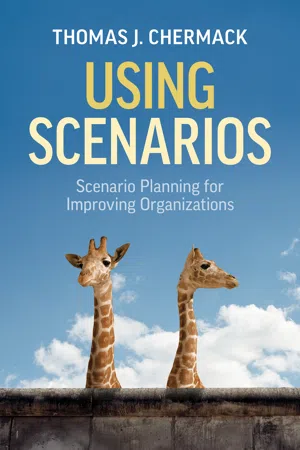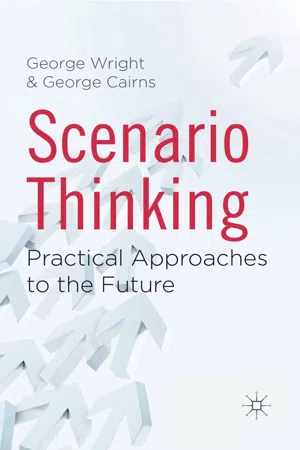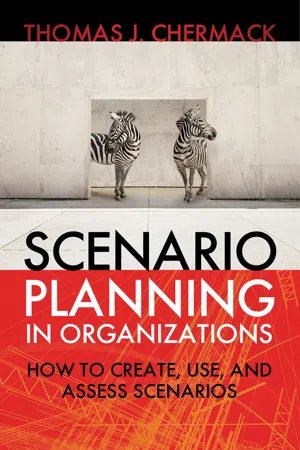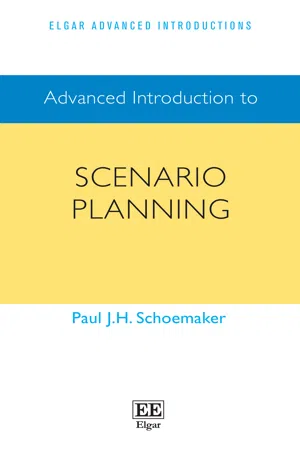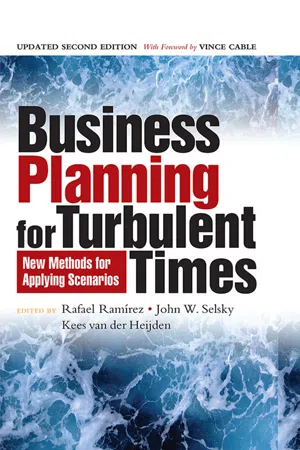Business
Scenario Analysis
Scenario analysis is a strategic planning technique that involves creating and analyzing different possible future scenarios to anticipate potential outcomes and make informed decisions. It helps businesses prepare for various situations by considering multiple factors such as market trends, economic conditions, and industry changes. By exploring different scenarios, organizations can develop robust strategies to adapt to changing environments.
Written by Perlego with AI-assistance
Related key terms
1 of 5
12 Key excerpts on "Scenario Analysis"
- eBook - ePub
- Rafael Ramírez, Ulf Mannervik;;;(Authors)
- 2016(Publication Date)
- ICP(Publisher)
Scenario planning has been used in companies since the 1960s (Lesourne & Stoffaes, 2001; Grant, 2003; van der Heijden, 2005) and even longer by military planners and policy-makers. It serves a wide variety of purposes, which may include efforts to reframe the understanding of a situation, to help to reperceive strategic opportunities, to improve the quality of strategic conversations, to correct judgement biases, to enhance organisational learning, to influence stakeholders, to help different parties identify and agree upon common ground, to create new relationships, to reach out to new co-creators, to surface and question assumptions in models or strategy; to make sense of ambiguous settings; to have a common language to join up disjointed organisational divisions; or to research and clarify complex issues.As Figure 7.1 illustrates, in scenario planning we distinguish between the more immediate business (or “transactional”) environment that a strategist (CEO or team in a firm) influences through their interactions with counterparts (who, from their point of view, are “actors” or “interactors”) from the “factors” around these interactors, which remain beyond the strategist’s influence — and which constitute and are situated in the broader “contextual” environment.Figure 7.1: The Transactional and the Contextual Environments2Scenarios are constructed by analysing the factors and how these might relate to each other in the future; and once a plausible contrasting set of such scenarios are constructed, then the inquiry moves into what transactional or business environment might arise in each of those scenarios.While there are very many “methods” to develop a set of scenarios in scenario planning, with different authors proposing different numbers of steps (for an overview see Ramírez & Wilkinson, 2016), all involve the aspects, which were summarised by Wilkinson, Selin and Ramírez in the Oxford Scenarios Programme (see Figure 7.2 ).Research has established that scenario planning is an approach well suited to support strategy in conditions where forecasting is either unreliable or less applicable. These conditions are turbulent environments (van der Heijden, 1996; Ramírez et al - eBook - PDF
Scenario Planning - Revised and Updated
The Link Between Future and Strategy
- Mats Lindgren, H. Bandhold(Authors)
- 2009(Publication Date)
- Palgrave Macmillan(Publisher)
It is also an effective learning tool. Thinking in scenarios helps us understand the logic of developments, clarify driving forces, key factors, key players and our own potential to exert an influence. Scenario planning is future planning in an era when traditional strategic planning is obsolete (Mintzberg 1994). In fact, scenario techniques can be used for several purposes, as we will see later. In Figure 2.3 we illustrate the dimensions we have discovered over the years of using scenario techniques in various projects. Sometimes scenarios are clearly used for planning reasons with an explicit aim to develop practical results. Industry, technology or consumer scenarios can guide R&D, business or product development. Scenarios may function both as inspirations for generating idea and as filters through which new ideas and projects can be passed. In these cases scenarios function within a ‘new business’ process. But they can Purpose: prerequisite for change Strategy/ planning Purpose: action Focus: new business Scenario learning Focus: old business Business development/ Concept development New thinking/ Paradigm shift Risk- consciousness/ Need for renewal Strategy development/ Organizational development Scenario- planning Innovation Evaluation Figure 2.3 Scenario projects could be used for different purposes and with different focuses An Introductory Overview 27 ......................................................................................................................................... also be used for evaluation purposes, for instance to test existing business concepts, strategies or products. At other times scenarios may be used for learning or to drive change. Scenarios are powerful in challenging existing paradigms and assumptions, especially for those who are involved in the scenario generation. Therefore, scenario workshops are powerful instruments in the process of challenging existing paradigms and creating shared perspectives on the future. - eBook - ePub
Scenario Planning for Climate Change
A Guide for Strategists
- Nardia Haigh(Author)
- 2019(Publication Date)
- Routledge(Publisher)
By considering multiple future scenarios far in advance of their potential emergence, and by identifying warning signals, scenario planning gives organizations more time to anticipate potential upcoming changes, and to develop a variety of cost-effective options to be implemented if and when needed. In this sense, scenario planning develops a keen sense of strategic timing that will enable you to stay ahead of emerging change, stay ahead of competitors, and decide when and how to respond. If you can relate to this statement by Harvard Business School – “if you wait for a trend to be validated … the window of opportunity will have closed or the threat will have already torpedoed your company” 1 – then scenario planning can help you to identify trends well ahead of their emergence, and enable you to get ahead of upcoming threats and opportunities by timing your response. In conclusion, a stand-alone five-year strategic planning process focused on a single view of the future is ineffective, and complementing it with scenario planning will help to overcome its limitations, while building valuable in-house capabilities to strategize rigorously and flexibly for the long term. References 1 Harvard Business School. 2000. Scenario planning reconsidered, Harvard Management Update, 5/9: 4. 2 Wilkinson, A. and R. Kupers. 2013. Living in the futures, Harvard Business Review, 91/5: 118–127. 3 Schwab, S.J. and R.S. Thomas. 2006. An empirical analysis of CEO employment contracts: What do top executives bargain for, Washington and Lee Law Review, 63: 231–270. 4 Wack, P. 1985. Scenarios: Shooting the rapids, Harvard Business Review, 63/6: 139–150. 5 Wade, W. 2012. Scenario Planning: A Field Guide to the Future. Hoboken, USA: John Wiley & Sons. 6 Schoemaker, P.J.H. 1995. Scenario planning: A tool for strategic thinking, Sloan Management Review, 36/2: 25–40. 7 Wack, P. 1985. Scenarios: Uncharted waters ahead, Harvard Business Review, 63/5: 73–89. 8 Sharot, T., A.M. Riccardi, C.M - eBook - ePub
- Alan L. Porter, Scott W. Cunningham, Jerry Banks, A. Thomas Roper, Thomas W. Mason, Frederick A. Rossini(Authors)
- 2011(Publication Date)
- Wiley(Publisher)
The Oxford English Dictionary provides three definitions of uncertainty. The second is the one with which the remainder of the chapter will be concerned (OED Online 2011): A sketch, outline, or description of an imagined situation or sequence of events; esp… . (b) an outline of an intended course of actionScenarios are a natural outgrowth of efforts to help organizations adapt to their rapidly changing environments. In assisting organizations in making decisions, forecasters face several problems. Qualitative techniques, such as checklists, often fail in the important tasks of engaging decision makers and facilitating organizational learning. On the other hand, solely quantitative approaches often are not appropriate. Moreover, narrow assumptions about the future can result in overly rigid prescriptions for future actions. Recognition of these issues has led to development of several distinct scenario methodologies.Strength, Weakness, Opportunities, Threats (SWOT) analyses were some of the precursors to modern Scenario Analysis approaches (Spies 1994). Newer approaches include the Shell scenario approach (Wack 1985a, 1985b; Schwartz 1991; Van der Heijden 2005), as well as the RAND planning approach (Dewar 2002; Lempert, Popper, et al. 2003). In the following sections, a methodology that integrates both of these perspectives is presented.7.2.1 Steps in Creating Scenarios
The narratives, in many ways, are the most characteristic feature of Scenario Analysis. However, a lot of preliminary work must precede them. There are five steps in constructing a scenario:- Identifying variables
- Developing levels of measurement
- Characterizing significant variables
- Creating scenarios
- Writing the narrative
Step 1 entails identifying meaningful external variables for the technological system in question. The technology delivery system constructed for the forecast will help, but the forecaster should think broadly and comprehensively, as if participating in a brainstorming exercise (see Section 4.3.7). For instance, he or she might search through the space of possible social, political, economic, institutional, legal, environmental, or technological variables that might affect the system. The variables that are identified are called scenario variables - eBook - PDF
The Plausibility of Future Scenarios
Conceptualising an Unexplored Criterion in Scenario Planning
- Ricarda Schmidt-Scheele(Author)
- 2020(Publication Date)
- transcript Verlag(Publisher)
2 Scenario planning: characteristics and current issues Since the past century, scenario planning has emerged as a very popular fo-resight technique. Originally developed for strategic war planning, the ideas have been mainstreamed for business and non-business environments, for in-stance through implementations by The Royal Dutch Shell, British Petroleum or British Airways (Ringland 2008). Today it covers a variety of methods for or-ganisations, governmental and non-governmental institutions and individu-als to systematically explore the future. The present proliferation of scenarios in sustainable energy transformations and climate change contexts (Moss et al 2010; Volkery & Ribeiro 2009) is a further proof of the enormous flexibility of the method. From a research perspective, the term ‘scenario’ covers a broad range of definitions and methodologies that are populated by dif ferent research com-munities. For instance, the Futures Studies literature mostly proposes quali-tative-driven scenario developments – with as some would call ‘softer’ under-standings of what a scenario is and ought to fulfil (Amer et al 2013; Börjeson et al 2006; Bradfield et al 2005; Godet 2000). In contrast, model-based scena-rio approaches put forth more specific understandings; here, scenarios result from di f ferent model runs and are supported by sensitivity analyses (Bishop et al 2006; Rogelij et al 2012; Sala et al 2000). Scenario planning attracts mo-re and more scholarly interest. The dif ferent research communities actively develop, apply, advance and criticise scenario planning methodologies from perspectives of management studies, economics, sociology or political sci-ences. More recently, increased cooperation and merging activities between dif ferent scenario approaches are evident – notably between qualitative sce-nario and quantitative model developments (Alcamo 2008; O’Mahony 2014; Weimer-Jehle et al 2016). - eBook - ePub
Using Scenarios
Scenario Planning for Improving Organizations
- Thomas J. Chermack(Author)
- 2022(Publication Date)
- Berrett-Koehler Publishers(Publisher)
Organizations need help. With interest in scenarios at an all-time high, there is a real opportunity to demonstrate their value, integrate them with strategy, and adopt them more widely. This requires going beyond interesting stories. Detailed guidance for using scenarios is needed.The solution should be obvious. To solve the problem and its two parts, scenarios need to be used, and they need to be integrated with strategy. This book presents seven approaches for applying and implementing scenarios for different outcomes:1. Connecting scenarios to a purpose 2. Generating strategies 3. Creating and stress-testing strategic plans with scenarios 4. Testing decisions and options with scenarios 5. Assessing the financial benefits of scenarios 6. Modeling financials with scenarios 7. Developing scenario signals and critical uncertainty dashboardsUsing Scenarios gives you the details you need to put scenarios into practice. Based on extensive experience and research, it is highly practical, and the logic is that if scenarios are put to use, they stand a much better chance of becoming a standard organizational planning activity. Corporate decision making is often very shortsighted, and with the tools provided in this book, you will be able to help leaders make more careful, thoughtful, and long-term decisions.The content is intended as a follow-on to my previous work on scenario planning, Scenario Planning in Organizations , although it could easily be “bolted” onto any other scenario building method. It does not matter which method you have used to create scenarios.The goal of this book is to advance scenario planning practice through detailed descriptions of seven different ways of using scenarios. Each is designed for achieving specific purposes and outcomes. Scenario planning has been slow to evolve, and one reason for the lack of development is a failure to explicitly show how to put scenarios into action. This book provides the necessary details and tools to improve current scenario planning practices. Exercise descriptions, templates, workshop structures, and guidance on how to apply the seven approaches are included. - eBook - PDF
Scenario Thinking
Practical Approaches to the Future
- G. Wright, G. Cairns(Authors)
- 2011(Publication Date)
- Palgrave Macmillan(Publisher)
We outline the various stages of our scenario method, each of which addresses a specific element of the analytic process. At this point, we must clarify that, in our experience, having a fairly tightly structured process makes it easier and more comfortable for participants to deal with the complexities, ambigu- ities and uncertainties of the content. The rigid structure provides a lifeline within the sea of turbulence. The initial approaches to scenario development that we outline have the common feature of enabling individuals and groups to Working with Scenarios: Introducing the Basic Method 19 ......................................................................................................................................... explore the limits of possibility for the unfolding of the issue under consideration over a specified timescale, within the confines of what is currently known, knowable and plausible. Whilst this approach will broaden the range of thinking beyond business-as- usual, the limits of possibility and plausibility that participants perceive may remain bounded. In Chapter 3, we explain some of the reasons for this, and offer some techniques for overcom- ing this limitation. Thereafter, in Chapters 4 and 5 we introduce and illustrate augmented scenario methods. The first of these is based upon deeper analysis, exploring individual “driving forces” in greater detail. The second involves broader engagement outside the organizational context, enabling and supporting development of scenarios that address the concerns of stakeholders beyond those with immediate involvement and interest. The latter approach is intended to expand your thinking to consider alternative social, organizational and environmental contexts. In Chapter 8, we introduce scenario approaches that challenge the notion that the future will be incremental, with consideration of transformational approaches. - eBook - ePub
Scenario Planning in Organizations
How to Create, Use, and Assess Scenarios
- Thomas J. Chermack(Author)
- 2011(Publication Date)
- Berrett-Koehler Publishers(Publisher)
Scenarios are like cherry trees: cherries grow neither on the trunk, nor on the large boughs; they grow on the small branches of the tree. Nonetheless, a tree needs a trunk and large branches in order to grow small branches. The global, macro-scenarios are the trunk; the large branches are the country scenarios developed by Shell operating companies, in which factors individual to their own countries—predetermined and uncertain—are taken into account and added. But the real fruits of the scenarios are picked at the small branches, the focused scenarios which are custom tailored around a strategic issue or a specific market or investment project. (p. 83)To apply scenarios in this tiered way, decision makers would have to entertain several rounds of scenario construction. This is why most single instances of scenario planning fail. For example, first the global/macro scenarios should be constructed. These simply set the context for the appropriate industry. These are likely to be scenarios that capture external factors only. Once complete, and depending on the size of the organization, decision makers can move into more specific scenarios focused on a region (in the case of a truly global organization with numerous regional offices) or a specific strategic issue. When scenario planning is adopted as a way of thinking in organizations, the ways in which scenarios can be used expands drastically.FIGURE 5.2 Scenarios Are Like Cherry TreesTo do specific analyses of parts of the business, one develops “focused scenarios” custom-tailored around a strategic issue, or a specific market or investment project. But you cannot start with such focused scenarios because you will almost certainly miss key things, or cast the focused scenarios in the wrong way. You must wide-angle first, to get the big picture, and them zoom in on your business specifics. (Wack, 1985a, p. 92)Some scenario planning experts favor a highly specific approach from the start. For example, Louis van der Merwe tells stories about scenario projects he has observed in which the facilitator spent two full days defining the initial strategic question. Asking the right question is important; and the more specific the purpose, the easier it is to assess upon project completion. However, the context, situation, decision maker conversations, and other information will determine the level of focus required. There are no hard rules here, but the context will usually indicate when enough detail is reached. Gaining people’s understanding and readiness to move forward is both hard to miss and a key indicator to proceed. - eBook - PDF
- Paul J.H. Schoemaker(Author)
- 2022(Publication Date)
- Edward Elgar Publishing(Publisher)
1 1. Introduction to scenario planning This book covers an important approach to managing uncertainty in con- trast to cases of risk where probabilities and outcomes can be readily cal- culated or estimated. The need for better ways of handling the unknown is especially high now. One reason is that economic, technological, social and political forces are becoming more complex: global climate change, the recent COVID-19 pandemic and our deeply divided world are prime examples. Second, intricate problems confronting society require more collaborative approaches at a time when distrust, polarization, and power politics overshadow deep dialog, science and rationality. Third, our culturally diverse organizations are struggling with unresolved pressures exacerbated by open network designs, evolving ecosystems and social media. One hallmark of scenario planning is that it can help provide structure and understanding in situations where people hold vastly different viewpoints and need to engage in constructive dialog. By fostering thoughtful discussions and exploration, scenario planning lets participants embrace a systematic way to develop diverse perspectives about what the future may bring. Scenario planning is especially valuable when team learning is important, or when deeply rooted mental models need to be surfaced and challenged to arrive at better strategies and implementations. This book has at least two distinct audiences. The first includes advanced practitioners and academics who already know a good deal about scenario planning. The second group, which is much larger, comprises students, managers, leaders, professionals and experts from other disciplines who may be somewhat familiar with the topic but want a deeper exploration. Since I belonged to this latter group when I learned serendipitously about scenario planning around 1980, it may be useful to recount some of that experience. - eBook - ePub
Business Planning for Turbulent Times
New Methods for Applying Scenarios
- Rafael Ramirez, John W. Selsky, Kees van der Heijden, Rafael Ramirez, John W. Selsky, Kees van der Heijden(Authors)
- 2010(Publication Date)
- Routledge(Publisher)
Enabling multiple perspectives on the future to be generated and evaluated simultaneously is crucial for managers in turbulent environments because it enables a richer set of response repertoires to be developed. In addition, the scenario-planning method structures the uncertainty that managers face from a contextual environment. It provides a sense of order, priority and significance that opens up choices, which differs from traditional strategic planning that is designed to eliminate choices. Scenario planning offers a structured way of capturing future contextual disruptions in whole systems in environments, instilling images previously not conceived of in the minds of participants (Schoemaker, 1993; Watkins and Bazerman, 2003; see also Chapter 12 in this volume). Ramírez and van der Heijden (2007, p97) suggest that strategic planning and scenario planning are best used in tandem. The transactional environment has been taken to be the usual arena for strategizing, and the contextual environment the usual arena for scenario planning. In this ‘wind tunnelling’ model, scenarios serve the function of questioning the boundary between the transactional and contextual environments, and delivering imaginative information to strategic planning. However, Ramírez and van der Heijden (2007) also suggest that strategic planning has been tethered to assumptions of a disturbed–reactive environment. They suggest that by using scenario planning in a new way, it might pull strategic planning into being more useful in a turbulent environment. They suggest an intervention called ‘staging inter-organizational futures’ can help managers to identify parts of the contextual environment that are misconstrued as non-controllable, and add these into transactional space amenable to strategic planning - eBook - PDF
Scenarios for Success
Turning Insights in to Action
- Bill Sharpe, Kees van der Heijden, Bill Sharpe, Kees van der Heijden(Authors)
- 2008(Publication Date)
- Wiley(Publisher)
We see this as part of the general shift in the field of strat-egy, from ‘business-as-usual’ to ‘game changing’, from ‘adapting’ to ‘shaping’, from ‘inside the box’ to ‘outside the box’ innovation, from ‘managing’ to ‘leading’. Gaining a new deep understanding of the strategic situation, now and in the future, remains one of the key objectives of the scenario practice. Without this there can be no ‘seeing the situation in a new way’ and therefore no strategic insight and renewal. The awareness is growing of the overlap between scenarios and systems approaches. We see fascinating attempts to use concepts from systems theory, such as dominant loops, to help scenario thinkers distil the essence of the situation they are describing. Some go so far as to describe scenarios as ‘systems in disguise’ and scenario building as systems analysis ‘without the need for specialists’. In this connection practi-tioners emphasize that good scenarios must be plausible, internally consistent and based on a causal structure. In addition, they see the power of the narrative in terms of efficiency of expression and weight in the battle for attention. It seems obvious that we can expect further major developments in this general direction. It is fascinating to see how the field is starting to come up with new links to entrepreneurial invention. Even if the strategic invention will always remain a highly personal moment, sce-nario practitioners are finding ways to prepare the ground for the CONCLUDING REMARKS 393 ...................................................................................................... ‘moment of magic’ when things fall into place; when you feel you now understand the basic forces driving value in the situation and what you need to do is staring you in the face. While scenario practitioners on the whole do not see themselves in the business of making strategic decisions, they do increasingly subscribe to Pasteur’s dictum that ‘luck favours the prepared mind’. - eBook - ePub
Scenario Thinking
Preparing Your Organization for the Future in an Unpredictable World
- George Cairns, George Wright(Authors)
- 2017(Publication Date)
- Palgrave Macmillan(Publisher)
compensatory method is the essence of the decision analysis approach to strategy evaluation against scenarios, that we now introduce in a more formal way. We also give clear, step-by-step guidelines on how to use this approach in the scenario method.Combining Scenario Thinking and Decision Analysis
As we have seen, in scenario practice evaluation of strategies against the decision maker’s strategic objectives is relatively informal. As we have discussed, when a number of objectives are involved, there are dangers in this informal process. Strategy evaluation may be incomplete or distorted because, unconsciously, undue attention is paid to particular objectives at the expense of others.In this chapter, we outline one way of formalizing the process of strategy evaluation that draws closely on the work of Goodwin and Wright (2001 , 2009 ), who first developed a systematic method to aid the process of evaluating strategies . We believe that the use of this technique can bring considerable advantages to Scenario Analysis. We present a simplified, less numerical, version of their approach below.The main stages of the approach are:- Stage 1: Formulate scenarios.
- Stage 2: Formulate the objectives that you wish to achieve in your strategic actions
- Stage 3: Design alternative strategies.
- Stage 4: For each objective, rank each strategy against each scenario from the best to the worst
- Stage 5: For each objective, rank all strategy–scenario combinations from best to worst
- Stage 6: Compute the sum-of-ranks for each strategy and provisionally select the best performing strategy
Example:
Index pages curate the most relevant extracts from our library of academic textbooks. They’ve been created using an in-house natural language model (NLM), each adding context and meaning to key research topics.
